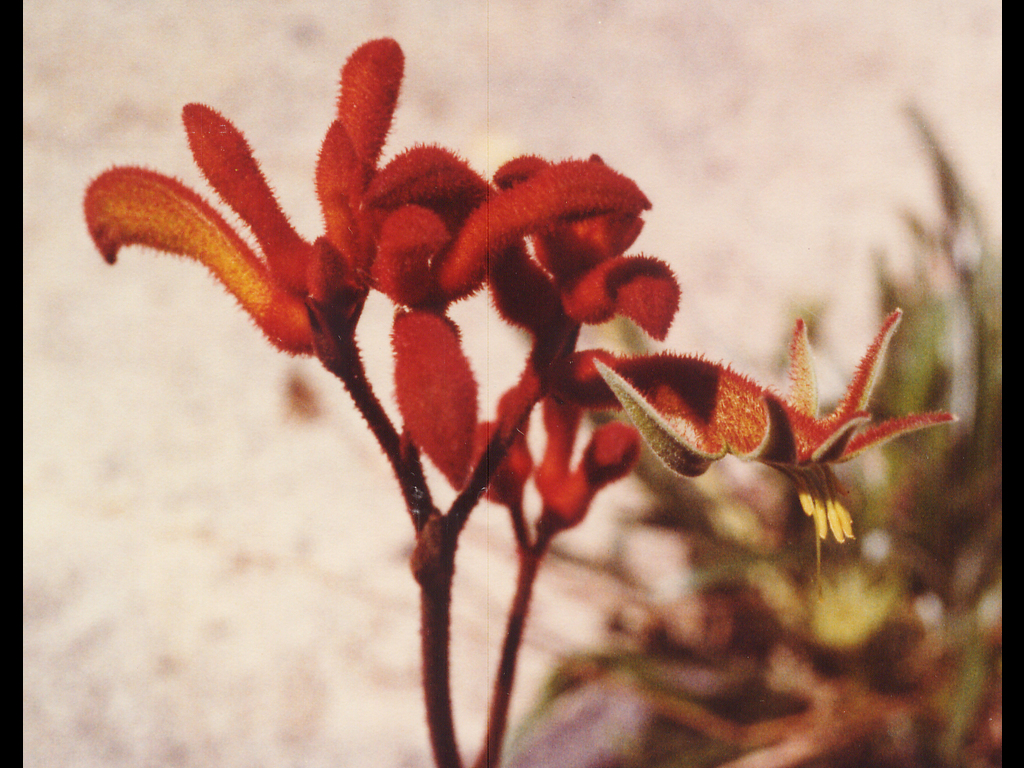Anigozanthos 'Charm'
- File Number
- 221
- ACRA Field Book Number
- 19
- Registration Date
- 15/10/1992
- Application Received
- 18/10/1983
- Family
- Haemodoraceae
- Cultivar Name
- Anigozanthos 'Charm'
- Origin
- Anigozanthos 'Charm' is a manipulated cross between A. flavidus and A. preissii made by Keith Oliver in 1973. This cultivar was first received by the Authority on 18 October 1983. Registration requested by K. R. Oliver, 44A Armstrong Rd, Wilson 6107 and Henry Haynes, 35 Armstrong Rd, Wilson 6107.
- Characteristics
- Note: Formerly A. 'Elegant Charmer' This cultivar is a neat 0.5m plant with glossy green leaves to 0.3 m. Flower stems are 1m and branched. Flowers are borne in September to November and are reddish orange with cream anthers. Diagnosis: A.flavidus grows to 1.0m tall by 1.0m wide. Flowers from October to February. Leaves are glabrous. The flower stems are 2.0m, branched and smooth tubular, 3-4cm densely hairy. The lobes are not turned back, colours are yellow-green, red, pink, yellow and green. Common in a wide range of soils and climate but frost damage can occur. Moist light to medium soils and partial to full sun seems best. Propagation is by seed or division. A.preissii grows to 0.6m tall by 0.3m wide. Flowers from August to November. Leaves are deciduous; sparse, nearly terete, finely pointed. Flower stems are 1.0m long, tubular, 5-6cm woolly hairs. Two terminal clusters , lobed but not reflexed. Claw-like in appearance, orange to yellow and red colour.Cultivation is difficult, prefers moist and well-drained soil in partial to full sun. Divide regularly to promote vigorous growth. Does well in containers. Propagation is by seed or division. Anigozanthos 'Charm' is a manipulated hybrid growing to 0.6m in height. Flowers from September to November. Leaves are glossy green, 0.3m in length. Flower stems are reddish-orange and the anthers are cream. A feature is the cultivar's resistance to snails and ink disease. Propagation is by vegetative means only. A. flavidus wild, lvs 1.0m h x1.0m w, fls Tubular; 3-4cm, densely hairy; lobes not turned back. Yellow-green, red, pink, yellow, green. Oct-Jan, scape height 2m A. preissii wild, lvs 0.6m h x 0.3, fls Tubular 5-6m, woolly hairs; 2 terminal cluster; lobed but not reflexed. Claw-like. Orange to yellow, red.Aug-Nov, scape height - 'Charm' manipulated hybrid, lvs 0.5m h, fls Reddish orange; cream anthers. Sept-Nov, scape height 1m Note: Sought registration as Anigozanthos 'Elegant Charmer' in September 1980.
- Cultivation
- Common wide range of soil and climate Moist light to medium soils; partial or full sun. Can be damaged by frost. Difficult in cultivation. Moist well drained soil; partial or full sun. Divide regularly to promote vigorous growth. Grows well in containers. Snail and ink disease resistant. Unpalatable to snails and resistant to ink disease.
- Publication
- -
- Colour Coding
- RHS Colour Chart 1966:hairs on all parts: Red group 46Aperianth tube, outside: Yellow-green 149Ainside: Yellow-green 145Aanthers: Greyed yellow 162Astyle: Yellow green 145A
- Propagation
- Division or tissue culture
- Applicant Name
- K.R. Oliver
- Uses
- As part of a mass planting or mixed in a shrubbery, or as a spectacular feature plant. Attracts nectar feeding birds.
- Availability
- Unknown
- ANBG Accession Numbers
- ACC221; ACRA019; CBG8312958.
- NSL ID
- -

